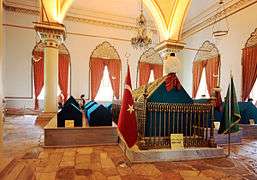Nilüfer Hatun
Nilüfer Hatun (Ottoman Turkish: نیلوفر خاتون, birth name Holifere (Holophira) / Olivera,[2] other names Bayalun, Beylun, Beyalun, Bilun, Suyun, Suylun[3]) was a Valide Hatun; the wife of Orhan, the second Ottoman Sultan. She was mother of the next sultan, Murad I. Her other son was "Kasım" (died 1346). Some older sources also claim she was mother of Orhan's first son, Süleyman Pasha, which is disputed.[4]
| Nilüfer Hātūn | |
|---|---|
 | |
| Valide Hatun of the Ottoman Beylik | |
| Tenure | 1362 – 1383 |
| Predecessor | position established |
| Successor | Devlet Hatun |
| Born | Holofira c. 1283 Bilecik, Byzantine Empire |
| Died | c. 1383 (aged 99–100) Bursa, Ottoman Sultanate |
| Burial | Muradiye Mosque, Bursa |
| Spouse | Orhan |
| Issue | Murad I Süleyman Pasha[1] |
| Father | Porphyrogennetos of Yahisar |
| Religion | Islam, previously Orthodox Christian |
Biography
The traditional stories about her origin, traced back to the 15th century, are that she was daughter of the Byzantine ruler (Tekfur) of Bilecik, called Holofira. As some stories go,[5] Orhan's father Osman raided Bilecik at the time of Holofira's wedding arriving there with rich presents and disguised and hidden soldiers. Holofira was among the loot and given to Orhan.
However modern researchers doubt this story, admitting that it may have been based on real events. Doubts are based on various secondary evidence and lack of direct documentary evidence of the time. In particular, her Ottoman name Nilüfer meaning water lily in Persian language.[4]
Other historians make her a daughter of the Prince of Yarhisar or a Byzantine Princess Helen (Nilüfer), who was of ethnic Greek descent.[6][7][8]
According to a source, in the spring of 1299, the Bilecik magistrate who was to marry the daughter of Yarhisar invited Osman Ghazi and his men to his wedding festivity. In the spring the Söğüt people migrated to Domaniς plateau until autumn. Osman Ghazi asked to leave all his belongings at the Bilecik castle before coming to the wedding. It was the usual practice in those years to entrust the heavy goods of encampment to neighbouring castles. The magistrate accepted gladly. The wedding would be in Chakirpinar, two hours away from Bilecik. On the way to the wedding, the magistrate of Yarhisar was encircled by Osman's soldiers. They turned back toward Yarhisar. When the people saw their magistrate, they opened the gates and Osman's soldiers got in. The conquest of the castle did not take long. At the Bilecik castle, one of the bales left by Osman Ghazi was opened. A soldier got out of it and informed others. Armed soldiers stepping out of the bales captured everyone in the castle. Bilecik had fallen to the Ottomans. While the guests were waiting for the bride, the horsemen of the Ottomans appeared. There was a big ceremony in Karacahisar. Orhan Ghazi would marry Holofira, the daughter of the Yarhisar magistrate. The young bride converted to Islam and became Nilüfer Hatun.[9]
Nilüfer Hatun Imareti ("Nilüfer Hatun Soup Kitchen"), a convent annex hospice for dervishes, now housing the Iznik Museum in İznik, Bursa Province, was built by Sultan Murad in 1388 to honor his mother after her death.[10]
See also
- Ottoman Empire
- Ottoman family tree
- Ottoman dynasty
- Line of succession to the Ottoman throne
- Ottoman Emperors family tree (simplified)
- List of the mothers of the Ottoman Sultans
- List of consorts of the Ottoman Sultans
Further reading
- Peirce, Leslie P., The Imperial Harem: Women and Sovereignty in the Ottoman Empire, Oxford University Press, 1993, ISBN 0-19-508677-5 (paperback).
- Yavuz Bahadıroğlu, Resimli Osmanlı Tarihi, Nesil Yayınları (Ottoman History with Illustrations, Nesil Publications), 15th Ed., 2009, ISBN 978-975-269-299-2 (Hardcover).
Notes and references
- Sakaoğlu, Necdet (2008). Bu mülkün kadın sultanları: Vâlide sultanlar, hâtunlar, hasekiler, kadınefendiler, sultanefendiler. Oğlak Publications. p. 38. ISBN 978-9-753-29623-6..
- Sakaoğlu, Necdet (2008). Bu mülkün kadın sultanları: Vâlide sultanlar, hâtunlar, hasekiler, kadınefendiler, sultanefendiler. Oğlak Publications. p. 39. ISBN 978-9-753-29623-6..
- Famous Ottoman women. Avea. 2007.
- Leslie P. Peirce (1993) "The Imperial Harem: Women and Sovereignty in the Ottoman Empire", ISBN 0-19-508677-5.
- "Diccionario histórico, ó Biografia universal compendiada" (1832) article Holofira
- The Fall of Constantinople, Steven Runciman, Cambridge University Press, p.36
- The Nature of the Early Ottoman State, Heath W. Lowry, 2003 SUNY Press, p.153
- History of the Ottoman Empire and Modern Turkey, Stanford Jay Shaw, Cambridge University Press, p.24
- Love Beyond Time, Mehmet Tanberk, iUniverse, p.170
- ""Nilüfer Hatun Soup Kitchen"". Archived from the original on 2013-12-15. Retrieved 2008-02-24.
| Ottoman royalty | ||
|---|---|---|
| New title | Valide Hatun 1362 – 1383 |
Succeeded by Devlet Hatun |
